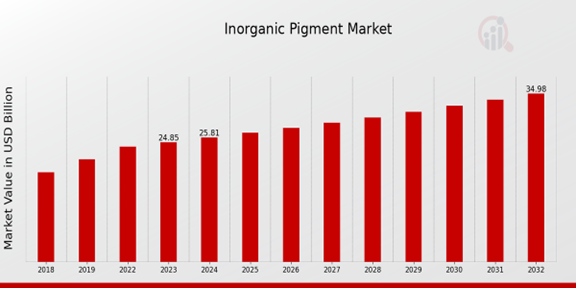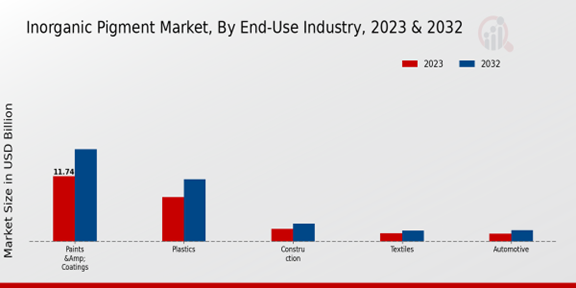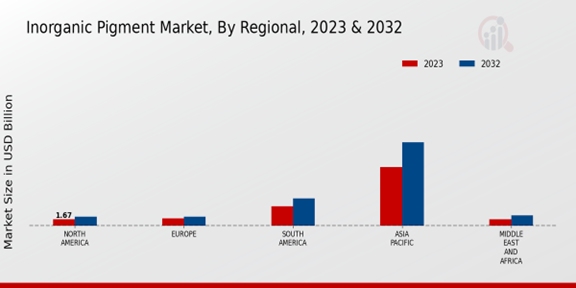Global Inorganic Pigment Market Overview
The Inorganic Pigments Market Size was estimated at 26.82 (USD Billion) in 2024. The Inorganic Pigment Industry is expected to grow from 27.86 (USD Billion) in 2025 to 39.21 (USD Billion) by 2034. The Inorganic Pigment Market CAGR (growth rate) is expected to be around 3.90% during the forecast period (2025 - 2034).
Key Inorganic Pigment Market Trends Highlighted
Key market drivers of the inorganic pigments market are the growing end-user industries such as construction, automotive, packaging etc. The growing focus of governments on the development of infrastructure and urbanization is likely to boost market growth.
The opportunities include the invention of advanced pigments, such as some of the modern eco-friendly pigments. The growing trend of green building and green products presents a competitive opportunity.
Recent trends show a spike in the use of inorganic pigments that are more durable, lightfast and weather-resistant. There has also been increasing activity in the area of colorants for food, cosmetics and pharmaceuticals.

Source: Primary Research, Secondary Research, MRFR Database and Analyst Review
Inorganic Pigment Market Drivers
Growing Demand for Inorganic Pigments in Construction and Automotive Industries
The construction and automotive industries are the major consumers of inorganic pigments, and the rising demand for both industries is expected to drive market growth. Inorganic pigments are consumed in various construction materials, such as paints, coatings, and plastics. The increasing construction industry, especially in the developing countries of the Asia-Pacific region, is expected to drive the demand for inorganic pigments in the coming years.Inorganic pigments are also used in automotive paints and coatings. The increasing production of automotive vehicles is expected to drive the demand for inorganic pigments for the automotive industry.
Advancements in Technology and Development of New Inorganic Pigments
New and advanced advancements in technology are prominent in the inorganic pigment market. The introduction of new inorganic pigments with better properties has propelled the growth of inorganic pigments. The color performance and durability offered by new pigments are enhanced due to their resistance to light fading, which has promoted the growth of this market. The advent of new inorganic pigments is expected to benefit this pigment market, which will attract customers from different industries for various applications, including plastics, building chemicals, construction markets, and automotive applications products.
Increasing Environmental Regulations and Focus on Sustainability
The interest in environmentally friendly inorganic pigments is growing due to government regulations and increasing consumer awareness toward environmental sustainability. Inorganic pigments are preferred over organic pigments primarily because of low environmental impact. The increasing demand for sustainable products in industries like construction and automotive is expected to promote the use of inorganic pigments, meeting environmental standards.
Inorganic Pigment Market Segment Insights
Inorganic Pigment Market End-Use Industry Insights
The Inorganic Pigment Market is divided by End-Use Industry into paint coatings, Plastics, Construction, Textiles, and Automotive. In 2023, the Paints Coatings segment held the largest share of the market, as inorganic pigments are in increasingly high demand in architectural and industrial coatings. The Plastics segment is expected to be the second-largest, and it will demonstrate a significant rise as the demand for inorganic pigments in plastic wares such as automotive products, toys, and packages will continually grow.The Construction segment is expected to display moderate growth as the demand for inorganic pigments in building materials, including cement, concrete, and tiles, continues its rise. The Textile segment is likely to demonstrate the slowest growth, as the demand for inorganic pigments in printing inks and dyes only slightly increases. The Automotive segment is expected to show a moderate rise as the demand for inorganic pigments in this kind of coating also experiences growth. Inorganic pigments are highly demanded by various industries because of their outstanding features such as high durability, colorfastness, and resistance to chemicals and UV rays.This will be due to the rising demand in the appropriate end-use industries. The Asia-Pacific region will hold the biggest share of the Inorganic Pigment Market, followed by North America and Europe. The Asia-Pacific region is expected to grow most rapidly as China and India gradually experience a rising demand for inorganic pigments overall. North America and Europe will experience stable growth as the demand for inorganic pigments in the automotive and construction industries continues to rise.

Source: Primary Research, Secondary Research, MRFR Database and Analyst Review
Inorganic Pigment Market Pigment Type Insights
By pigment type segmentation, the Inorganic Pigment Market is differentiated into Titanium Dioxide, Iron Oxide, Cadmium, Carbon Black, and Chromium Oxide. The Titanium Dioxide segment accounts for the highest market share in 2023 and is likely to continue its dominance throughout the forecast period. This type is commonly used in the paints, coatings, plastics, and paper industries due to its favorable whiteness, brightness, and UV resistance. The Iron Oxide segment is another prominent category, owing to the thriving construction, automotive, and cosmetics industries that contribute to its increasing demand.The Carbon Black type is generally used to manufacture rubber and tires, aiming to enhance the strength and resilience of the final product. The Cadmium and Chromium Oxide categories are largely utilized in the production of special-purpose pigments for ceramics, glass, and electronics. In general, the Inorganic Pigment Market revenue is forecasted to reach USD 27.48 Billion in 2024 by demonstrating a steady growth.
Inorganic Pigment Market Form Insights
The Form segment of the Inorganic Pigment Market is categorized into Dry, Paste, and Liquid. Among these, Dry Inorganic Pigments held the largest market share in 2023, accounting for around 58.1%. The dominance of Dry Inorganic Pigments can be attributed to their ease of handling, storage, and transportation, as well as their wide range of applications in various industries. Paste Inorganic Pigments are projected to witness a steady growth rate during the forecast period, primarily driven by their high concentration and suitability for specific applications such as printing inks and coatings.Liquid Inorganic Pigments, on the other hand, are anticipated to gain traction due to their ease of dispersion in various formulations and their growing adoption in industries like automotive and construction. The Inorganic Pigment Market revenue for Dry, Paste, and Liquid Forms is expected to reach USD 16.47 billion by 2024, showcasing the significant growth potential of this market segment.
Inorganic Pigment Market Regional Insights
The Inorganic Pigment Market is segmented into North America, Europe, APAC, South America, and MEA. Among these regions, APAC is expected to dominate the market in the coming years due to the increasing demand for inorganic pigments in the automotive and construction industries. The growth in the automotive industry in countries such as China and India is driving the demand for inorganic pigments, as these pigments are used in paints and coatings for vehicles. Additionally, the rising construction activities in the region are also contributing to the market growth.North America and Europe are mature markets for inorganic pigments, with well-established end-use industries such as automotive, construction, and packaging. The growth in these regions is expected to be steady, driven by the increasing demand for high-performance pigments in various applications. South America and MEA are emerging markets for inorganic pigments with significant growth potential. The increasing urbanization and industrialization in these regions are driving the demand for inorganic pigments in paints, coatings, plastics, and other applications.The Inorganic Pigment Market is expected to witness significant growth in the coming years, driven by the increasing demand from various end-use industries.

Source: Primary Research, Secondary Research, MRFR Database and Analyst Review
Inorganic Pigment Market Key Players And Competitive Insights
The Inorganic Pigment Market is shaped by the presence of well-established players, each having its inherent strengths and offerings. Taking top companies in the industry, including BASF, Lanxess, Huntsman, Clariant, and Heubach, the number one factor that makes them stand out among other manufacturers is the share each one holds in the market and the resulting responsibility for driving innovation and product development and leading new technological advancements in the industry. Another feature of the Inorganic Pigment Market is the high level of competition observed. Companies seek to expand their market share through partnerships, acquisitions, and investments in research and development. Additionally, mergers and joint ventures are additional instruments that increase the range of products the company may offer, thus furthering its competitive edge.
The first leading company in the industry is namely BASF, which is known in the market for its deep and comprehensive portfolio of inorganic pigments that includes titanium dioxide, iron oxides, and carbon black. BASF is also known for its such advantage as an excellent brand strength and a strong reputation in the market as well as its commercial delivery that spans the globe. At the same time, the company is known for its commitment to sustainability and research scale, which brings about a series of advanced pigment technologies aimed at enhancing performance specifically for the automotive, construction, and plastics industries. The company is also known for its extensive distribution network and strong partner network that includes such companies as ACE and Kärntner Montanindustrie or globally recognized chemical and materials corporation Solvay. These partners ensure the strong market presence of the company. At the same time, the number one competitor in the Inorganic Pigment Market is Heubach, which is known to produce a broad range of organic and inorganic pigments characterized by a unique focus on the high performance of pigments. The company also has a footprint with manufacturing facilities across North and South America, Europe, and Asia. The in-depth focus on research and development of the company finds expression in its extensive use of patent protection for its products and solutions. It also offers excellent customer service and solutions, especially for customers in such areas as the automotive, coatings, and plastics. At the same time, following the widespread trends, environmental responsibility, and sustainability are another strong suit of the company.
Key Companies in the Inorganic Pigment Market Include
- Ferro Corporation
- BASF SE
- Tronox Holdings Plc
- Sachtleben Chemie GmbH
- Heubach Group
- Clariant A
- Sun Chemical
- Cabot Corporation
- Lanxess AG
- Huntsman International LLC
- DIC Corporation
- KRONOS Worldwide, Inc.
- Huber Engineered Materials
- The Shepherd Color Company
- Elementis Plc
- Evonik Industries AG
Inorganic Pigment Market Industry Developments
Rising demand for inorganic pigments in various industries, including construction, automotive, and packaging, is driving market growth.Recent developments in the inorganic pigment market include the launch of new products, expansions, and acquisitions. For instance, in 2023, Lanxess expanded its inorganic pigments production capacity in Ningbo, China, to meet the growing demand for high-performance pigments in the Asia-Pacific region. Key players in the inorganic pigment market include BASF, Clariant, DIC Corporation, and Huntsman Corporation.
Inorganic Pigment Market Segmentation Insights
Inorganic Pigment Market End-Use Industry Outlook
- Paints Coatings
- Plastics
- Construction
- Textiles
- Automotive
Inorganic Pigment Market Pigment Type Outlook
- Titanium Dioxide
- Iron Oxide
- Cadmium
- Carbon Black
- Chromium Oxide
Inorganic Pigment Market Form Outlook
Inorganic Pigment Market Regional Outlook
- North America
- Europe
- South America
- Asia-Pacific
- Middle East and Africa
| Report Attribute/Metric |
Details |
| Market Size 2024 |
26.82 (USD Billion) |
| Market Size 2025 |
27.86 (USD Billion) |
| Market Size 2034 |
39.21 (USD Billion) |
| Compound Annual Growth Rate (CAGR) |
3.90% (2025 - 2034) |
| Report Coverage |
Revenue Forecast, Competitive Landscape, Growth Factors, and Trends |
| Base Year |
2024 |
| Market Forecast Period |
2025 - 2034 |
| Historical Data |
2020 - 2024 |
| Market Forecast Units |
USD Billion |
| Key Companies Profiled |
Ferro Corporation, BASF SE, Tronox Holdings Plc, Sachtleben Chemie GmbH, Heubach Group, Clariant A, Sun Chemical, Cabot Corporation, Lanxess AG, Huntsman International LLC, DIC Corporation, KRONOS Worldwide, Inc., Huber Engineered Materials, The Shepherd Color Company, Elementis Plc, Evonik Industries AG |
| Segments Covered |
End-Use Industry, Pigment Type, Form, Regional |
| Key Market Opportunities |
Growing demand for eco-friendly paints Pigments for automotive coatings Increasing use in construction materials Emerging applications in electronics and semiconductors Expansion in emerging markets. |
| Key Market Dynamics |
Growing Construction Industry Technological Advancements Increasing Demand for Specialty Pigments Regulatory Compliance Environmental Concerns |
| Countries Covered |
North America, Europe, APAC, South America, MEA |
Frequently Asked Questions (FAQ) :
The inorganic pigment market is expected to reach a valuation of USD 27.86 Billion in 2025.
The inorganic pigment market is projected to register a CAGR of 3.90% from 2025 to 2034.
Asia-Pacific is expected to dominate the inorganic pigment market throughout the forecast period.
Inorganic pigments are used in a wide range of applications, including paints and coatings, plastics, rubber, paper, and ceramics.
Key competitors in the inorganic pigment market include BASF, Clariant, DIC Corporation, and Lanxess.
The growth of the inorganic pigment market is driven by increasing demand from the construction and automotive industries.
The inorganic pigment market faces challenges such as environmental regulations and the availability of raw materials.
The inorganic pigment market is expected to reach a valuation of USD 39.21 Billion by 2034.
The plastics segment is expected to grow the fastest during the forecast period.
Key trends in the inorganic pigment market include the development of new and sustainable pigments and the growing demand for low-VOC and VOC-free pigments.

















